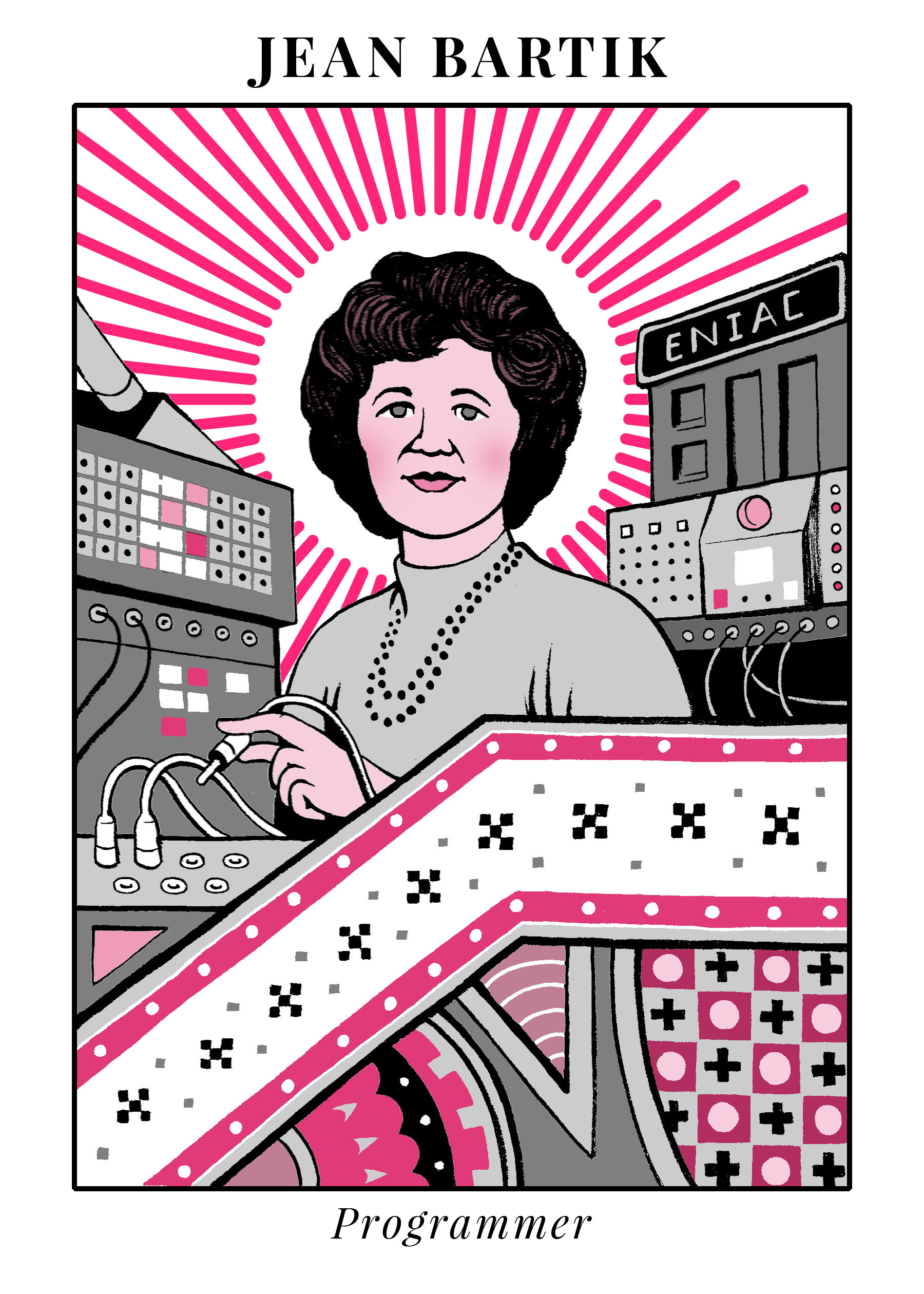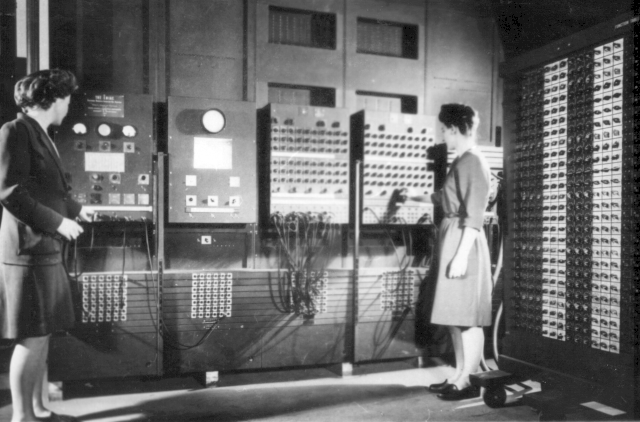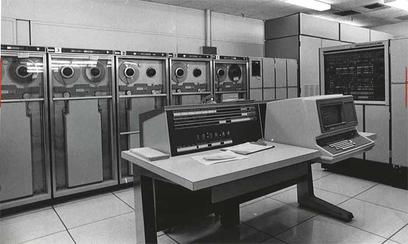5 facts about Jean Bartik, expert programmer of the world's first computer
"The ENIAC was a son of a b**** to program"
1. At age 20, Bartik became one of the first “computers”
In 1945, farm-grown Jean Jennings Bartik (born Betty Jean Jennings) finished her degree in mathematics at Northwest Missouri State University and was ready for her next adventure. She saw an ambiguous advertisement in the paper for “college women with a degree in mathematics,” applied, and was offered the job. The next night she hopped on a steam-powered train from her small rural town to the bustling city of Philadelphia. Her expertise was needed for a specific reason: to compute the trajectories of ballistic missiles.

Illustration by Matteo Farinella
The missile trajectories depended on specific weather and atmospheric conditions, which were entered into a complex equation in order to generate an entire table of values. The Army needed mathematically-savvy people for these calculations, but all the men were fighting the war. So, they offered a $2,000 salary to over 100 women to work at the University of Pennsylvania as "computers." For most of World War II, all of the computers and their supervisors were women. Each ballistic table took 40 hours to compute, and as the war continued, the demand for calculations was overwhelming.
2. She programmed the first electronic computer
The Army decided to launch a secret project to automate these calculations, which soon became known as the Electronic Numerical Integrator and Calculator (ENIAC). With the pioneering work of Bartik and five other women, known as the “Sensational Six,” ENIAC became the first computer that could be programmed for multiple purposes – the predecessor to our modern day computers. Bartik was the youngest woman in the group.
The process of programming ENIAC was painstaking. Despite being integral to ENIAC’s development, at first the women weren’t given clearance to enter the huge room that contained the 80-foot long mass of steel, cables, switches, and 16,000 vacuum tubes. The women were given circuit diagrams of the ENIAC and challenged with the task of figuring out how it all worked - and how to program it.
Bartik was responsible for the math. Once the women had worked it all out on paper, they were granted clearance to actually interact with the machine. The hard work wasn't over though – programming ENIAC meant physically moving all of the cables and thousands of switches as they’d designed. In Bartik’s own words, “The ENIAC was a son of a bitch to program.”
With their designs, the computer was ultimately able to compute ballistic tables in seconds. The Army announced its accomplishment and set a public demonstration date. On Valentine's Day, 1946, Bartik and her colleague Betty Snyder were up late fixing the 30-ton machine. "Most people consider Valentine's Day a romantic day," Bartik writes, "but we never gave a thought that evening of valentines or romantic dinners. What we were thinking of was an all-important demonstration we were to run next day for the world."

Jean Bartik, left, and Frances Bilas, right, programming the ENIAC computer
The demonstration was an enormous success, but none of the women were even introduced during it. Afterwards, there was a celebratory dinner with invited scholars from near and far. The women were sent home.
3. Her contributions to computing didn’t end there
Before our computers were packed with apps, or even basic strings of commands, they couldn’t remember anything. John Mauchly and J. Presper Eckert, the masterminds behind the ENIAC, went on to engineer machines that could flexibly store information (EDVAC) as well as the first commercial computer (UNIVAC). They hired Bartik and Synder as the sole UNIVAC programmers, challenged with crafting the UNIVAC's ability to read and record data from reels of magnetic tape. Bartik worked on multiple iterations of the UNIVAC, and she warmly reflects on this part of her career. In 1951, a UNIVAC computer correctly predicted that Dwight Eisenhower would win the 1952 election, despite all signs pointing towards Adlai Stevenson.

The UNIVAC 1108, circa 1970
Promotional photo distributed in 1969, used under fair use
In total, Bartik spent four decades of her life programming, designing, and promoting the possibility of computers.
4. She had a longstanding interest in writing
Bartik originally went to college for journalism, but she soon realized she couldn’t afford to attend journalism school after college. Luckily for the future of computing, she also had a longstanding interest in math: “I had always considered mathematics as fun, like solving puzzles, thus more of a game than a subject for serious study.” Ultimately, she received a degree in mathematics with a minor in English.
In 1951, Bartik stopped working on computing machines in order to raise her children. During this time, she also completed a master’s degree in English at the University of Pennsylvania. In 1967, she began to work for Auerbach Corporation as a writer and editor of technical reports on computers, combining her two great academic interests. She went on to various other jobs as a product manager and editor, and spent the last years of her working life as a real estate agent. (She died in 2011 at the age of 86.)
5. She was a persistent champion of women in computer science
All of the ENIAC programmers were women. Yet, the history of computing – even decades later – did not usually mention them. After looking at the program for a history of computing panel in 1975, Bartik wrote the chair of the seminar about how ridiculous it was to not include women. As a result, he asked her to speak. The experience inspired her to write an autobiography about all of the instances she and her female colleagues were left behind in history.
Each step of the way in her telling was a fight. When all of the men returned from the war, many companies, such as IBM, fired all of their women to rehire the men. Bartik fought to maintain her position, and was one of few women able to do so. Although she received outstanding performance reviews at Auerbach each year, Bartik was never promoted. She went to the local Equal Employment Opportunity Commission, which was investigating multiple cases of discrimination against women in Philadelphia. They were deeply interested in her case, and encouraged her to collect as much information on her productivity as possible. However, filing a lawsuit required time and money that she didn't have as a single mother with three children . Bartik's fight happened on a smaller scale - insisting that she be allowed to smoke, or going to higher managers when her direct supervisors wouldn't listen to her ideas. Even when her ideas were implemented, she was reprimanded for such challenges to their authority.
The ENIAC women were almost completely forgotten until 1986, when a Harvard undergraduate, Kathy Kleinman, wrote her thesis (and ultimately made a documentary) on early women in computing. Fortunately, Kleinman grabbed the attention of Wall Street Journal writer Tom Petzinger, who wrote articles about the full story of ENIAC’s development. Bartik didn’t receive any formal credit for her work on the first computer until 1997, when she was in her 70s.
As for young women in computer science now, Bartik says, "you should be prepared, and work hard –everybody that succeeds must work hard – and open the door when opportunity knocks. Opportunity comes in a lot of different ways. But I do believe that you should enjoy what you do."